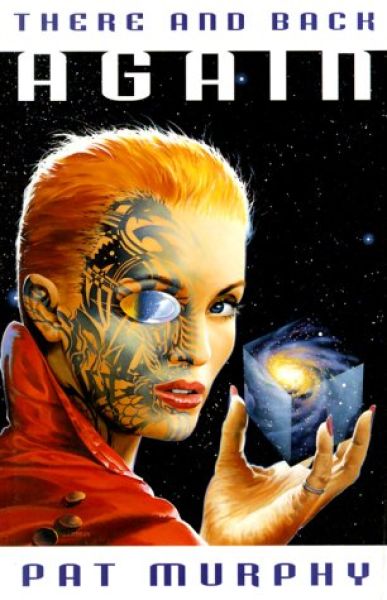There and Back Again by Max Merriwell
There and Back Again by Max Merriwell
By Pat Murphy

9 Sep, 2014
0 comments
This is a bit unusual for the Rediscovery series in that while I opened my copy knowing I would ultimately recommend the book, I also went into this knowing that aside from used copies there’s pretty much no way for any of you folks to acquire a copy. I had fun rereading it, though, and isn’t that the important thing?
Centuries in the future, the Solar System has been settled by humans and their derivative varieties and thanks to a combination of hibernation and implausibly (but carefully never explained) Nearly as Fast as Light Hoshi drives, so have the nearer stars. Even better, an alien network of wormholes provides access to the greater galaxy.
There is a catch with the wormhole network, or rather a number of catches:
- Wormholes connect systems as close as tens of light years apart and as distant as thousands of light years apart.
- The only way to find out whether a wormhole leads to a nearby star or the center of the galaxy is to go through.
- Wormholes are one-way, so absent a series of wormholes that happen to lead back to where one began, the only way home is the slow way home, traveling one year into the future for every light year traversed.
- The aliens didn’t leave any maps lying around, leaving trial and error as the only other method to find one’s way around the Milky Way.
The Farr clone family decided to take the long view by tossing radio beacons through every wormhole they found, then waiting for the radio broadcast from the probes to reach the clones’ vast radio telescope facilities at Farr Station in the Epsilon Eridani system. Individual clones will never see the great project completed but the clan will. By the time the book begins, they know where a hundred or so wormholes lead, and are aware of some loops.
None of this matters to Bailey Beldon, a norbit living a quiet life in the asteroidal backwaters of the Solar System, or at least it doesn’t until he has the … let’s call it fortune to pick up a battered message beacon addressed to the Farrs. Being a polite man, he lets the Farrs know what he had discovered, a decision that brings old family friend Gitana to his door, leading a collection of Farr clones. The message offers new routes and at the end of them, treasure beyond compare.
Bailey isn’t quite genre-aware enough to hide under his bed until his visitors have gone away and one drunken revel later, he finds himself years from home (as measured in the Solar System’s frame), committed to accompanying the clones as they traverse an extremely hostile galaxy in search of their lost sister’s great treasure. It doesn’t help that the Farr clones are seen as ambulatory fungible resources by the Resurrectionists or that the clones have a peculiar talent for alienating people who might otherwise be allies.
And even if the adventurers manage to make it the core of galaxy alive and free, the Snark waiting for them and it is familiar with their kind.
I first read this 15 years ago and called it charming then. I am happy that on a reread, I still find it charming. The author makes it clear that the inspiration for this is Tolkien’s The Hobbit but while there are parallels, this isn’t some thumb-fingered one-to-one mapping of a fantasy onto a science fiction setting, some act of crude derivation by a hack. Bailey’s universe is quite different from Bilbo Baggins’ universe; Tolkien’s world is slowly winding down and Bilbo’s great discovery foreshadows a vast calamity, whereas Bailey lives a brighter universe than Bilbo, one where the idea of a happy ending is not a sad joke.
I was oddly reminded of some of the more amiable science fantasies of Clifford Simak, although Murphy is the better writer. I think it’s the uncharted portal network, which features in the (obscure) Shakespeare’s Planet and also the fact that while there are some very unpleasant beings in this universe, there are also people with whom one could imagine sharing a porch with as the sun sets in whichever direction it sets on the world where the porch is located. It’s not the Bellum omnium contra omnes that is the norm for so much science fiction, which is probably why I like this book so much.
Max Merriwell is either a pen name of Pat Murphy’s or alternatively the name of a successful science fiction writer who is in some universe closely related to ours a friend of a Pat Murphy. That Max Merriwell also writes fantasies under the pen-name Mary Maxwell and mysteries as Weldon ; people interested in Merriwell’s fantasies should keep an eye out for Wild Angels, by Mary Maxwell, by Max Merriwell by Pat Murphy. Readers will also want to find a copy of Murphy’s Adventures in Time and Space with Max Merriwell, in which a simple holiday voyage becomes an exploration of reality.
Most of Murphy’s books can be purchased here. Sadly, not all homages are accepted as such and it is, I believe, for that reason this particular book is out of print.
